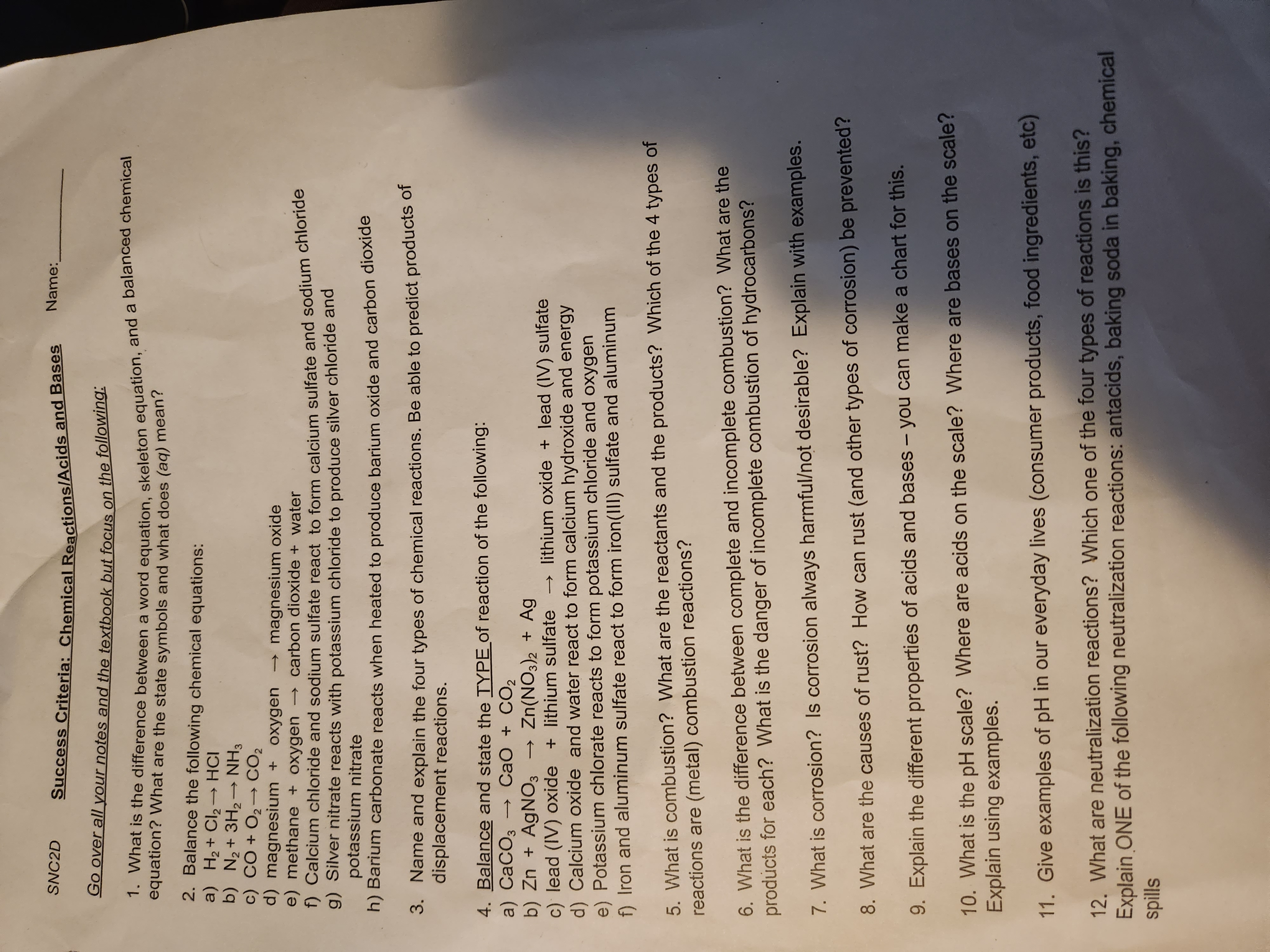1. What is the difference between a word equation, skeleton equation, and a balanced chemical equation? What are the state symbols and what does (aq) mean? 2. Balance the following... 1. What is the difference between a word equation, skeleton equation, and a balanced chemical equation? What are the state symbols and what does (aq) mean? 2. Balance the following chemical equations: a) H2 + Cl2 -> HCl b) N2 + 3H2 -> NH3 c) CO + O2 -> CO2 d) magnesium + oxygen -> magnesium oxide e) methane + oxygen -> carbon dioxide + water f) Calcium chloride and sodium sulfate react to form calcium sulfate and sodium chloride g) Silver nitrate reacts with potassium chloride to produce silver chloride and potassium nitrate h) Barium carbonate reacts when heated to produce barium oxide and carbon dioxide 3. Name and explain the four types of chemical reactions. Be able to predict products of displacement reactions. 4. Balance and state the TYPE of reaction of the following: a) CaCO3 -> CaO + CO2 b) Zn + AgNO3 -> Zn(NO3)2 + Ag c) lead (IV) oxide + lithium sulfate -> lithium oxide + lead (IV) sulfate d) Calcium oxide and water react to form calcium hydroxide and energy e) Potassium chlorate reacts to form potassium chloride and oxygen f) Iron(III) sulfate and potassium sulfate react to form iron(III) sulfate and aluminum 5. What is combustion? What are the reactants and the products? Which of the 4 types of reactions are (metal) combustion reactions? 6. What is the difference between complete and incomplete combustion? What are the dangers of incomplete combustion of hydrocarbons? 7. What is corrosion? Is corrosion always harmful/not desirable? Explain with examples. 8. What are the causes of rust? How can rust (and other types of corrosion) be prevented? 9. Explain the different properties of acids and bases – you can make a chart for this. 10. What is the pH scale? Where are acids on the scale? Where are bases on the scale? Explain using examples. 11. Give examples of pH in our everyday lives (consumer products, food ingredients, etc). 12. What are neutralization reactions? Which one of the four types of reactions is this? Explain ONE of the following neutralization reactions: antacids, baking soda in baking, chemical spills.

Understand the Problem
The question is asking for comprehensive answers to various aspects of chemical reactions and their properties. It covers topics like the differences between types of chemical equations, balancing reactions, types of reactions, combustion, corrosion, and the pH scale. The user needs to apply their knowledge of chemistry to each of these points.
Answer
The assignment covers chemical equations, types of reactions, combustion, corrosion, acids and bases, pH scale, and neutralization.
The assignment covers key chemistry concepts including chemical equations, reaction types, combustion, corrosion, acids and bases, the pH scale, and neutralization reactions.
Answer for screen readers
The assignment covers key chemistry concepts including chemical equations, reaction types, combustion, corrosion, acids and bases, the pH scale, and neutralization reactions.
More Information
This is a comprehensive chemistry assignment that requires an understanding of several fundamental chemistry topics, often taught in high school.
Tips
For balancing equations, make sure to count each type of atom on both sides of the equation. Remember the conservation of mass.
AI-generated content may contain errors. Please verify critical information